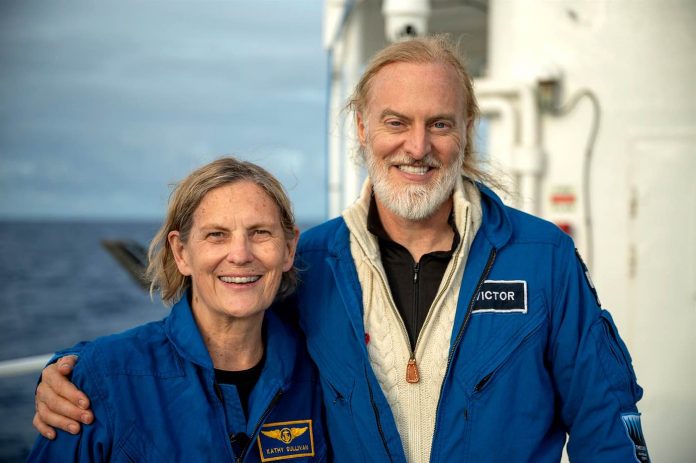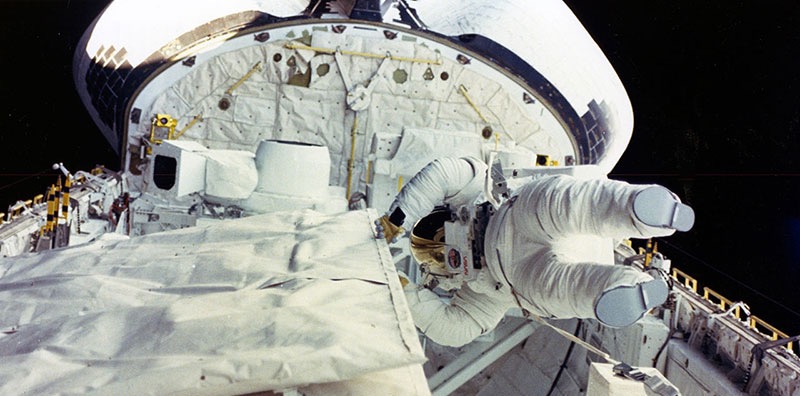The submersible Limiting Factor, a two-person craft piloted by Victor
Vescovo, after a dive to the deepest known point of the Mariana Trench
in the Pacific last year.
Credit...Tamara Stubbs/Atlantic Productions for
Discovery Channel, via Associated Press
From NYTimes by William J. Broad
The mountaineer Vanessa O’Brien dove to the Challenger Deep, seven miles below the surface of the sea.
The second of two women has made history by diving to the ocean’s deepest spot: the Challenger Deep, the lowest point of the Mariana Trench, the greatest of the sea’s many recesses.
The long fissure of the western Pacific lies 200 miles southwest of Guam.
The deep’s muddy bottom lies nearly seven miles down in inky darkness under crushing pressure.
Vanessa O’Brien
“I made it,” Vanessa O’Brien, 55, a star of adventure tourism, tweeted after emerging Friday from the icy abyss.
She called herself the first woman “to Earths highest & lowest points!”
Kathy Sullivan and Victor Vescovo
Enrique Alvarez / EYOS Expeditions
Enrique Alvarez / EYOS Expeditions
Kathy Sullivan becomes US woman to walk in space – NASAachiev
Both women are passengers of Victor L.Vescovo, a wealthy investor who has climbed Mount Everest and last year piloted a mini submarine into the Challenger Deep.
His innovative craft is up for sale, and earlier this year a London firm was selling dives on the expedition for $750,000.
Men who have made the descent include James Cameron, the maker of the “Avatar” and “Titanic” films, who explored the deep in a 2012 dive, and two Navy divers in 1960.
Dr. Sullivan became the eighth person in history to reach the deep’s bottom, and the first woman.
Mr. Vescovo calls his diving venture Caladan Oceanic, after a water-covered planet in the science-fiction saga “Dune.”
His two-person craft features an inner five-foot sphere made of titanium, a superstrong metal, and three portholes the size of dinner plates.
He had it built by Triton Submarines, a company in Sebastian, Fla.
The diving vessel and its mother ship cost $48 million.
In a recent profile, The New Yorker described Mr. Vescovo as part of an elite group of explorers setting the last meaningful records on Earth.
In an email Tuesday, Mr. Vescovo said that Ms. O’Brien was paying for her dive but gave no specific figure.
“Funds she provides will allow me to fund longer science missions in the northern Mariana Trench,” he wrote.
Those dives are planned for July, Mr. Vescovo said.
Mr. Vescovo added that Ms. O’Brien’s financial contribution would help pay not only for her own dive but also for the expedition’s monthlong seabed mapping effort for the National Oceanic and Atmospheric Administration and a project of the International Hydrographic Organization known as the General Bathymetric Chart of the Oceans.
Ms. O’Brien told Forbes in April that she decided to pay for her part of the expedition in lieu of signing up backers, as extreme adventure fans often do.
“It didn’t seem appropriate to try and find sponsors,” she said, at a time when the global coronavirus pandemic had upended so many lives.
Vanessa Audi Rhys O’Brien grew up in Grosse Pointe Farms, Mich., worked for Barclays and Morgan Stanley and is the author of a forthcoming memoir, “To the Greatest Heights.”
The book describes Ms. O’Brien’s fall from the corporate ladder during the 2009 economic downturn and her quest for new meaning in global mountaineering.
In the depths of the global ocean, the line between raw exploration and adventure tourism has long been murky.
In 1985 the deteriorating hulk of the Titanic was discovered some 73 years after the luxury liner, said to be unsinkable, struck an iceberg on its maiden voyage and went down in waters more than two miles deep, resulting in the loss of more than 1,500 lives.
By 2003, scientists warned that visitors in newly capable miniature submarines were endangering the world’s most famous shipwreck.
Assailed by explorers, moviemakers, salvors and tourists — including a couple that was married on its sunken bow — as well as rust and seabed creatures, the iconic liner was described as rapidly falling apart.
It is not uncommon for tourist-dive companies to perform a measure of scientific research as an adjunct to their commercial ambitions.
In an interview last year, Mr. Vescovo said that he saw his own push for deep exploration — including what his team has called the world’s first crewed “expedition to the deepest point in each of the five oceans” — as helping rekindle interest in the planet’s lifeblood.
“Hopefully, it will spur more interest in the ocean and real science,” he said.
“No one has ever been to these places before and measured them. We’d like to continue to see that done. I hope it leads to a renaissance in deep-sea exploration.”
Links :
- BBC : Kathy Sullivan: The woman who's made history in sea and space
- GeoGarage blog : Inside the daring mission to reach the ... / For the first time ever, travelers can join an expedition to the deepest spot in the oceans / An explorer took a $48 million submarine on .. / The stunning underwater picture this ... / Victor Vescovo: Adventurer reaches deepest ... / Stories of an extraordinary world : the last of ... / Wall Street trader reaches bottom of Atlantic ... / Mariana Trench: Deepest-ever sub dive ...




BBC : Mariana Trench: Don Walsh's son repeats historic ocean dive
ReplyDelete